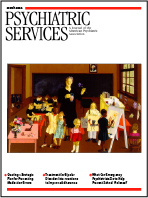The Availability of Psychiatric Programs in Private Substance Abuse Treatment Centers, 1995 to 2001
Abstract
OBJECTIVE: The high rate of co-occurrence of substance abuse and mental disorders renders the availability of psychiatric programs, or integrated service delivery, a vital quality-of-care issue for substance abuse clients. This article describes the availability of psychiatric programs and integrated care for clients with severe mental illness in the private substance abuse treatment sector and examines these patterns of service delivery by profit status and hospital status. METHODS: Survey data from the National Treatment Center Study, which is based on a nationally representative sample of privately funded substance abuse treatment centers, were used to identify the proportion of centers that offered psychiatric programs in 1995-1996, 1997-1998, and 2000-2001. Centers reported whether they treated clients with severe mental illness on-site or referred them to external providers. Repeated-measures general linear models were used to test for significant changes over time and to assess mean differences in service availability by profit status and hospital status. RESULTS: About 59 percent of private centers offered a psychiatric program, and this proportion did not significantly change over time. The proportion of centers that referred clients with severe mental illness to external providers increased significantly from 57 percent to 67 percent. For-profit centers and hospital-based centers were significantly more likely to offer psychiatric programs and were less likely to refer severe cases to other providers. CONCLUSIONS: Although the importance of integrated care for clients with dual diagnoses is widely accepted, data from the private substance abuse treatment sector suggest that this pattern of service delivery is becoming less available.



